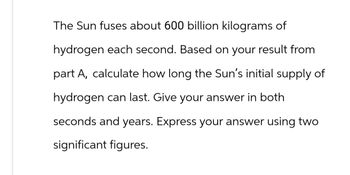
Elements Of Electromagnetics
7th Edition
ISBN: 9780190698614
Author: Sadiku, Matthew N. O.
Publisher: Oxford University Press
expand_more
expand_more
format_list_bulleted
Concept explainers
Question

Transcribed Image Text:The Sun fuses about 600 billion kilograms of
hydrogen each second. Based on your result from
part A, calculate how long the Sun's initial supply of
hydrogen can last. Give your answer in both
seconds and years. Express your answer using two
significant figures.
Expert Solution
This question has been solved!
Explore an expertly crafted, step-by-step solution for a thorough understanding of key concepts.
Step by stepSolved in 3 steps with 8 images

Knowledge Booster
Learn more about
Need a deep-dive on the concept behind this application? Look no further. Learn more about this topic, mechanical-engineering and related others by exploring similar questions and additional content below.Similar questions
- In a fusion reaction, two deuterium nuclei (each of mass 2.014 u) fuse together and form Helium-3 (3.016 u) and a neutron (1.009 u). Determine the energy liberated from this reaction (in MeV). Answer to 3 digits.arrow_forwardexplain each step please.arrow_forwardPlease help to solve complete solution.arrow_forward
- Thermodynamics T-11 All air is removed (vacuumed) from a 2 liter closed container that contains 200 ml of Liquid A and 600 ml of Liquid B at a temperature of 20C. At this temperature Liquid A has a density of 0.825 g/ml and vapor pressure of 25 kPa. Liquid B has a density of 0.750 g/ml and vapor pressure of 15 kPa. What is the mol fraction of vapor from Liquid A in the head space above the liquid surface? A) .25 B) .38 C) .63 D) .75arrow_forwardNOTE: This is a multi-part question. Once an answer is submitted, you will be unable to return to this part. Oxygen is heated from 700 to 1000 R. Determine the enthalpy energy change Ah of oxygen, in Btu/lbm, using the cp value at the average temperature from the table. (You must provide an answer before moving on to the next part.) The enthalpy energy change of oxygen is 218 Btu/lbm.arrow_forwardSubject: mechanicalarrow_forward
- The attached figure shows a gas contained in a vertical piston– cylinder assembly, where D = 10 cm. A vertical shaft whose cross-sectional area is 0.8 cm2 is attached to the top of the piston. The total mass of the piston and shaft is 25 kg. While the gas is slowly heated, the internal energy of the gas increases by 0.1 kJ, the potential energy of the piston–shaft combination increases by 0.2 kJ, and a force of F = 1668 N is exerted on the shaft as shown in the figure. The piston and cylinder are poor conductors, and friction between them is negligible.The local atmospheric pressure is 1 bar and g = 9.81 m/s2. (Patm = 1 bar) Determine, (a) the work done by the shaft, (b) the work done in displacing the atmosphere, and (c) the heat transfer to the gas, all in kJ.arrow_forwardAn electric hot water heater consumes 3.1 kilowatts of electricity and converts it to heat. How long will it take the water heater to heat a 67 gallon tank of water from 10 degrees Celsius to 50 degrees Celsius? (1 kilogram of water is 0.37 gallons, 1 Calorie = 4200 J). It may be helpful to refer back to the weekly handout for guidance on this problem. Your final answer should be in minutes (rounded to the nearest 10 minutes).arrow_forwardIn a given experiment, we want to study the expansion of a gas from state i to state f by three different paths in the pV diagram. Based on the following figure, where the pressure is indicated in atmospheres and the volume in liters, determine the work done by the gas, in joules: (a) Along the path iaf (b) Along the path if. (c) Along path ibf.arrow_forward
- Using 1st and 2nd law of thermodynamics for irreversible expansion of Krypton: Krypton (ideal monatomic gas) is confined in one-fourth of a 48-litre container. The other part of the container is evacuated. When the partition is removed, the gas expands and fills the whole container, while the system loses 400J of heat to the environment at 290K. It is found that in the final state, the Krypton is at p2 = 5.5bar, T2 = 400K. Is this process possible or not? (?k?????? = 83.8 kg/kmol)arrow_forwardP-4 Please I need help with this question needed a very clear and step-by-step explanation and needed with clear handwriting please, will be really appreciated your help.arrow_forward
arrow_back_ios
arrow_forward_ios
Recommended textbooks for you
 Elements Of ElectromagneticsMechanical EngineeringISBN:9780190698614Author:Sadiku, Matthew N. O.Publisher:Oxford University Press
Elements Of ElectromagneticsMechanical EngineeringISBN:9780190698614Author:Sadiku, Matthew N. O.Publisher:Oxford University Press Mechanics of Materials (10th Edition)Mechanical EngineeringISBN:9780134319650Author:Russell C. HibbelerPublisher:PEARSON
Mechanics of Materials (10th Edition)Mechanical EngineeringISBN:9780134319650Author:Russell C. HibbelerPublisher:PEARSON Thermodynamics: An Engineering ApproachMechanical EngineeringISBN:9781259822674Author:Yunus A. Cengel Dr., Michael A. BolesPublisher:McGraw-Hill Education
Thermodynamics: An Engineering ApproachMechanical EngineeringISBN:9781259822674Author:Yunus A. Cengel Dr., Michael A. BolesPublisher:McGraw-Hill Education Control Systems EngineeringMechanical EngineeringISBN:9781118170519Author:Norman S. NisePublisher:WILEY
Control Systems EngineeringMechanical EngineeringISBN:9781118170519Author:Norman S. NisePublisher:WILEY Mechanics of Materials (MindTap Course List)Mechanical EngineeringISBN:9781337093347Author:Barry J. Goodno, James M. GerePublisher:Cengage Learning
Mechanics of Materials (MindTap Course List)Mechanical EngineeringISBN:9781337093347Author:Barry J. Goodno, James M. GerePublisher:Cengage Learning Engineering Mechanics: StaticsMechanical EngineeringISBN:9781118807330Author:James L. Meriam, L. G. Kraige, J. N. BoltonPublisher:WILEY
Engineering Mechanics: StaticsMechanical EngineeringISBN:9781118807330Author:James L. Meriam, L. G. Kraige, J. N. BoltonPublisher:WILEY

Elements Of Electromagnetics
Mechanical Engineering
ISBN:9780190698614
Author:Sadiku, Matthew N. O.
Publisher:Oxford University Press

Mechanics of Materials (10th Edition)
Mechanical Engineering
ISBN:9780134319650
Author:Russell C. Hibbeler
Publisher:PEARSON

Thermodynamics: An Engineering Approach
Mechanical Engineering
ISBN:9781259822674
Author:Yunus A. Cengel Dr., Michael A. Boles
Publisher:McGraw-Hill Education

Control Systems Engineering
Mechanical Engineering
ISBN:9781118170519
Author:Norman S. Nise
Publisher:WILEY

Mechanics of Materials (MindTap Course List)
Mechanical Engineering
ISBN:9781337093347
Author:Barry J. Goodno, James M. Gere
Publisher:Cengage Learning

Engineering Mechanics: Statics
Mechanical Engineering
ISBN:9781118807330
Author:James L. Meriam, L. G. Kraige, J. N. Bolton
Publisher:WILEY